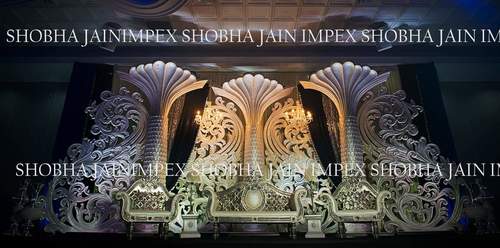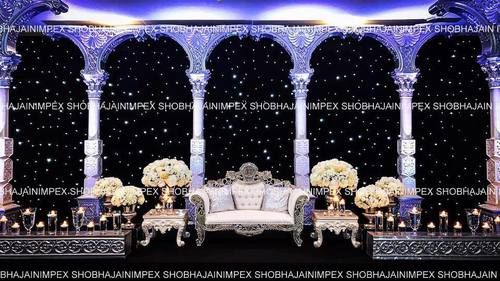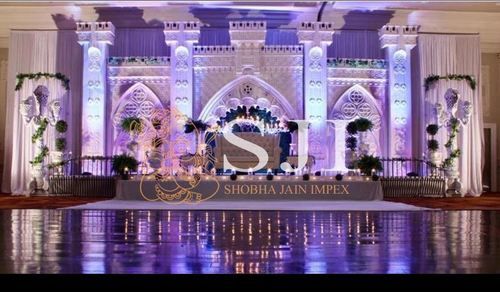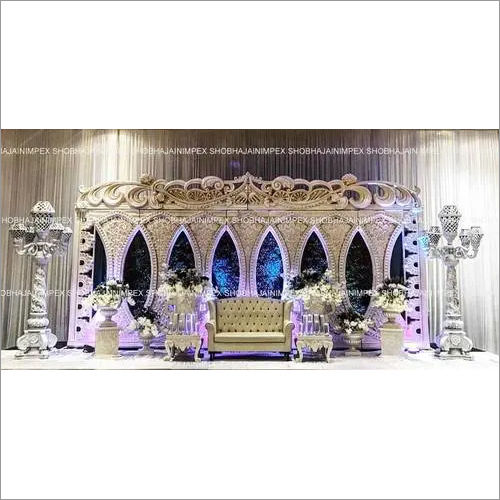Grand Indian Wedding Stage
200000.00 - 1000000.00 NZD ($)
Product Details:
- Product Type Others
- Occasion Wedding
- Material Wood
- Use Wedding Use
- Color Mix Color
- Click to View more
X
Grand Indian Wedding Stage Price And Quantity
- 1 Set
- 200000.00 - 1000000.00 NZD ($)
Grand Indian Wedding Stage Product Specifications
- Mix Color
- Wedding Use
- Wedding
- Others
- Wood
Grand Indian Wedding Stage Trade Information
- 100 Set Per Day
- 10 Days
- All India
Product Description
A Grand Indian Wedding Stage is a centerpiece of extravagance and grandeur at traditional Indian weddings. In Indian culture, weddings are celebrated with great pomp and splendor, and the wedding stage plays a pivotal role in the overall decor and festivities.
Here are some key elements and features of a Grand Indian Wedding Stage:
1. Ornate Design: The stage is typically designed with intricate and ornate details, often featuring intricate carvings, floral motifs, and architectural elements that reflect the rich cultural heritage of India.
2. Floral Decor: Flowers are a significant part of Indian wedding decor. The stage is adorned with an abundance of fresh flowers, such as roses, marigolds, jasmine, and orchids. Flower garlands, arches, and arrangements are commonly used to create a vibrant and colorful ambiance.
3. Backdrop: A stunning backdrop is a focal point of the wedding stage. It can be a massive floral arrangement, a traditional mandap (a decorative canopy), a fabric drapery with intricate designs, or a combination of these elements. The backdrop often features the couple's initials, religious symbols, or personalized designs.
4. Seating for the Couple: The bride and groom sit on the stage during various wedding ceremonies. They are often seated on elaborately decorated thrones or chairs, which are elevated to give them a regal appearance.
5. Lighting: Lighting plays a crucial role in creating a magical atmosphere. The stage is typically illuminated with a combination of ambient and decorative lighting, including chandeliers, fairy lights, and colorful LED lights. These lights enhance the stage's aesthetics and create a romantic ambiance.
6. Traditional Elements: Depending on the cultural and regional preferences of the couple, the wedding stage may include traditional elements such as statues of deities, cultural artifacts, or symbols of significance.
7. Color Scheme: The color scheme for the wedding stage is often chosen to match the overall theme of the wedding. Vibrant and auspicious colors like red, gold, and royal blue are commonly used.
8. Seating for Guests: In some Indian weddings, the stage is designed to accommodate close family members and guests who wish to take photos with the newlyweds. This area is often separated from the main seating arrangements for guests.
9. Entertainment and Performances: The wedding stage can also serve as a platform for cultural performances and entertainment during the wedding festivities. Dancers, musicians, and other artists may perform on or near the stage.
10. Personalization: Many couples choose to personalize their wedding stage with elements that reflect their unique love story, interests, or themes that are meaningful to them.
A Grand Indian Wedding Stage is not just a decorative element; it is a symbol of the couple's commitment and the coming together of two families. It is a space where traditions, rituals, and celebrations are held, making it one of the most cherished aspects of an Indian wedding.
Enter Buying Requirement Details
Other Products in 'Wedding Stages' category
Our major export markets are United State, Canada, United Kingdom, Asia, Australia, Central America, North America, South America, Eastern Europe, Western Europe and Middle East.







 English
English Spanish
Spanish French
French German
German Italian
Italian Chinese (Simplified)
Chinese (Simplified) Japanese
Japanese Korean
Korean Arabic
Arabic Portuguese
Portuguese







